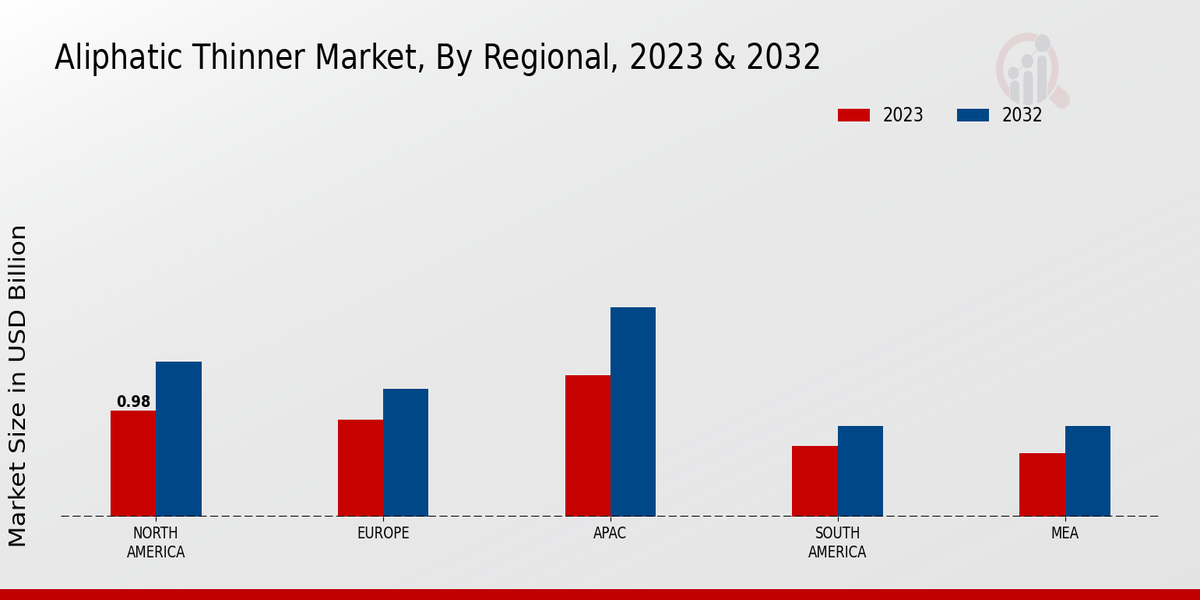Growth of the Construction Sector
The Global Aliphatic Thinner Market Industry is closely tied to the growth of the construction sector, which is experiencing a renaissance in many regions. As urbanization accelerates, the demand for construction materials and finishing products rises, leading to increased consumption of paints and coatings that utilize aliphatic thinners. This sector's expansion is anticipated to significantly contribute to the market's growth, with projections indicating a market value of 4.76 USD Billion in 2024. The construction industry's recovery and expansion are likely to sustain this momentum, further driving the demand for aliphatic thinners in the coming years.
Market Trends and Growth Projections
The Global Aliphatic Thinner Market Industry is characterized by evolving market trends that indicate a positive growth outlook. The market is projected to reach 4.76 USD Billion in 2024, with a compound annual growth rate of 3.84% anticipated from 2025 to 2035. This growth is driven by various factors, including increased demand from the automotive and construction sectors, as well as advancements in formulation technologies. The market's expansion reflects broader economic trends and the ongoing shift towards sustainable practices in industrial applications, positioning aliphatic thinners as a vital component in numerous manufacturing processes.
Rising Demand in Paints and Coatings
The Global Aliphatic Thinner Market Industry experiences a notable surge in demand driven by the expanding paints and coatings sector. As industries increasingly prioritize aesthetic appeal and protective finishes, the need for high-quality thinners becomes paramount. In 2024, the market is projected to reach 4.76 USD Billion, reflecting a growing preference for aliphatic thinners due to their low toxicity and environmental compliance. This trend is further supported by the construction and automotive industries, which are significant consumers of paints and coatings, thereby propelling the aliphatic thinner market forward.
Emerging Markets and Economic Development
Emerging markets are playing a pivotal role in the Global Aliphatic Thinner Market Industry, as economic development in these regions fosters increased industrial activity. Countries in Asia-Pacific and Latin America are witnessing rapid urbanization and industrialization, leading to heightened demand for paints, coatings, and related products. This trend is expected to bolster the aliphatic thinner market, with a projected growth trajectory that aligns with the overall economic growth in these regions. The anticipated market value of 7.2 USD Billion by 2035 underscores the potential for aliphatic thinners to thrive in these burgeoning economies.
Technological Advancements in Formulations
Technological innovations in the formulation of aliphatic thinners are reshaping the Global Aliphatic Thinner Market Industry. Advances in chemical engineering and formulation science have led to the development of thinners that offer improved performance characteristics, such as faster drying times and enhanced solubility. These innovations cater to the evolving needs of various industries, including automotive and furniture manufacturing, where efficiency and quality are paramount. As manufacturers adopt these advanced formulations, the market is expected to maintain a robust growth rate, with a projected CAGR of 3.84% from 2025 to 2035.
Regulatory Compliance and Environmental Standards
The Global Aliphatic Thinner Market Industry is significantly influenced by stringent regulatory frameworks aimed at reducing volatile organic compounds (VOCs) in industrial applications. Governments worldwide are implementing regulations that favor the use of environmentally friendly thinners, which enhances the appeal of aliphatic thinners due to their lower environmental impact. This regulatory push not only aligns with global sustainability goals but also encourages manufacturers to innovate and develop products that meet these standards. As a result, the market is likely to see a steady growth trajectory, contributing to its projected value of 7.2 USD Billion by 2035.




















Leave a Comment